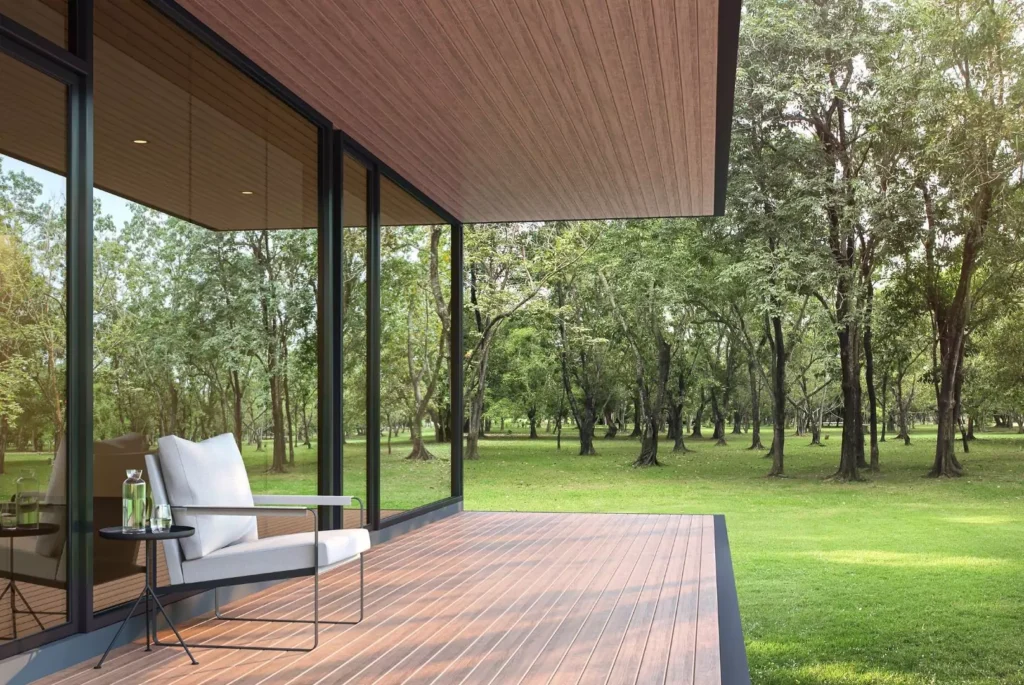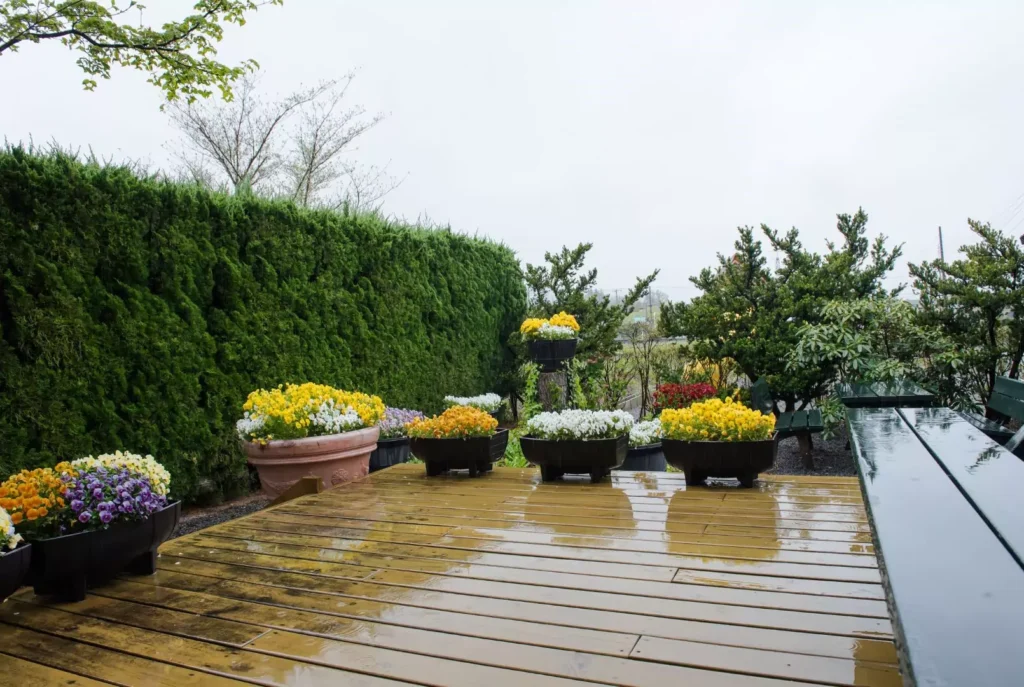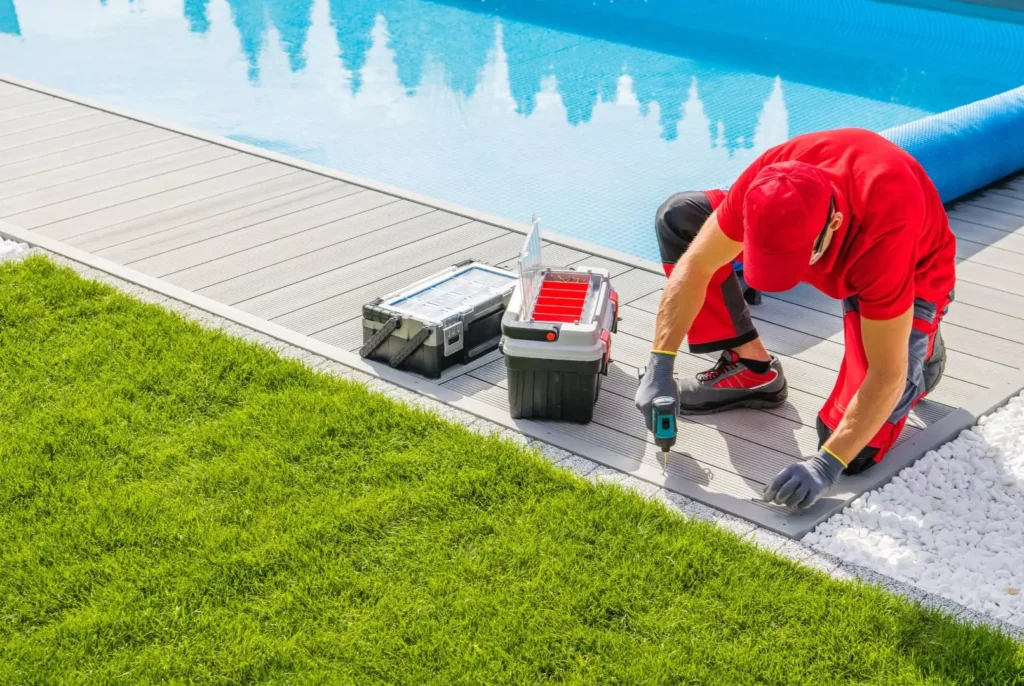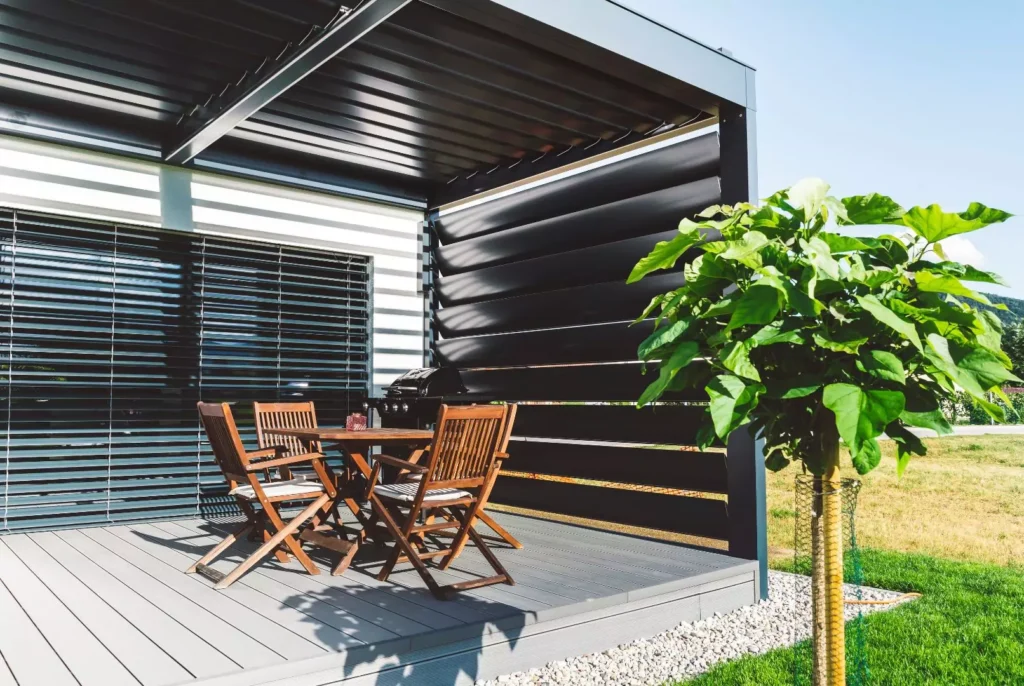Composite decking has significantly revolutionised the way US homeowners envision outdoor spaces. Through a combination of durability, aesthetic appeal and low maintenance costs, they have become a very popular choice for finishing decks and patios, especially in the northeastern states. This article provides an in-depth analysis of composite decking boards and shows its advantages and disadvantages, comparing it to natural wood products. With this article, you will also learn whether composite decking would be the right choice for your project.
What Exactly Composite Decking Boards are?
Composite decking boards are engineered products made from a combination of wood fibers and plastic polymers. Typically, their ratio is about 50% fiber to 50% polymer, although this can vary from manufacturer to manufacturer. These two main ingredients work together, as wood fiber provides a natural look and stiffness, while plastic ensures resistance to moisture and decay. The main components of commonly used polymers are polyethylene (PE), polypropylene (PP) and polyvinyl chloride (PVC). These sheets are produced by an extrusion process, in which they are heated, mixed and formed into the desired shape.

Popular Brands in the Northeastern United States
Several brands have established a strong presence in the northeastern U.S. market due to their quality and innovation.
- Trex: Often considered a pioneer in designing composite decking boards, Trex offers products made from 95% recycled materials, including reclaimed wood and plastic film.
- TimberTech: Known for its high-performance decking, TimberTech provides both capped composite and 100% PVC boards with a focus on natural wood aesthetics.
- Fiberon: Offering a range of products, Fiberon emphasizes sustainability and durability, with options that include capped composites and PVC decking.
These brands have built reputations based on product longevity, warranty offerings, and a variety of styles and colors to suit different preferences.
What Advantages do Composite Decking Boards Have?
One of the most important advantages of composite decking boards is their durability. Composite boards, unlike natural wood, are resistant to rot, decay and insects. They are designed to withstand the elements, a key feature especially in the Northeast, where the materials are exposed to both cold winters and hot summers.
Another important advantage is low maintenance costs. Wood requires staining, sealing and painting. Composite decking, on the other hand, only needs regular cleaning with soapy water to keep it looking fresh. This solution saves homeowners time and money, over the lifetime of the terrace.

It is also worth mentioning that high-quality composite boards, are resistant to fading under UV radiation. This means that they retain their original color. While some fading occurs in the first few months as the decking adapts to environmental conditions, manufacturers such as Trex or TimberTech provide a fade and stain warranty lasting as long as 30 years.
Another important feature is their resistance to mold. The likelihood of mold growth on the material is minimized by the plastic, which prevents moisture absorption. This is especially important in humid climates or places close to bodies of water
Composite decking boards tend to be lighter than those made from hardwoods, making them easier to handle during installation. However, they are heavier than most softwoods, such as pine or cedar.
From an environmental standpoint, there is also the advantage that in a large number of cases, composite decking is created from recycled materials. Manufacturer Trex reports that it uses 400 million pounds of plastic and wood waste annually, avoiding landfills.
Disadvantages of Composite Decking Boards
In addition to the many advantages mentioned earlier, there are also disadvantages. One of them is the cost of purchase, which is higher than most natural wood options. The average cost of composite decking is $9 to $16 per linear foot, while pressure-treated pine decking costs about $3 to $7. If we were to take a 500-square-foot deck, for example, the materials alone will cost us between $4,500 and $8,000, which is much more than the $1,500 to $3,500 for pine.
Although composite boards are easy and inexpensive to maintain, they are not immune to everything. Stains from oils, wines or other substances that are not cleaned in a timely manner can be problematic. In addition, the older generation of composite decking boards were still prone to fading, but over the past few years, as written above, the situation in this aspect has improved significantly.

Another disadvantage of composite decking is that it is prone to heat up when exposed to direct sunlight, which is a very inconvenient feature during the summer, when it is possible to walk around outside barefoot. In an attempt to solve this problem, some manufacturers have begun to offer boards in lighter colors that absorb less light, but even so, this issue is a big concern for potential customers.
Aesthetically, a disadvantage for some homeowners is the visibility that the boards are not all-natural. Some prefer the natural variation and character of authentic wood. The various grain patterns and color options introduced on the market have improved the visual appeal, although the texture and feel are still very different from natural wood. This cannot be considered a general disadvantage of composite decking, as much in this regard depends on taste, but for some it will be a decisive disadvantage of such a solution.
Comparing Manufacturers’ Claims with Real-World Performance
Products offered by composite decking manufacturers are often promoted as low-maintenance solutions. Common warranties range from 25 to 50 years and cover issues such as structural integrity, fading and staining. At the same time, it is worth remembering that the actual performance of the decking can vary depending on various factors, such as the correctness of the installation performed, environmental conditions and usage patterns.
In practice, many users of composite decking report satisfaction with the longevity and appearance of the products they purchased. Along the way of composite decking development, problems such as low resistance to fading and mold have arisen, but this has been resolved with technological developments. A method that improves the material’s performance in these aspects is co-extrusion. It adds a protective layer around the core of the board. As a result, in newer generations of composite decking boards, such problems no longer occur.

It is important to follow the manufacturer’s installation and maintenance recommendations during use to maximize the material’s performance. It is a good idea to use the services of a qualified decking contractor. This will help you avoid common installation mistakes, such as improper spacing or ventilation, which can have a negative impact on the durability of the terrace.
Natural Wood Decking Options
Natural wood still remains a popular choice for decking due to its authenticity and, in some cases, lower upfront cost. Common wood species used in the northeastern U.S. include:
- Pressure-Treated Pine: Affordable and widely available, treated to resist rot and insects. Requires regular maintenance to prevent warping and splintering.
- Cedar and Redwood: Naturally resistant to decay and insects, with a rich appearance. Costs range from $6 to $10 per linear foot.
- Tropical Hardwoods (e.g., Ipe, Mahogany): Extremely durable and resistant to wear, with lifespans of 25 to 40 years. However, they are expensive, costing $8 to $15 per linear foot, and can be challenging to work with due to their density.
Wood decks require more maintenance than composites, including annual sealing or staining to protect against moisture and UV damage. Over time, natural wood can warp, crack, or develop splinters, necessitating repairs or replacement of composite decking boards.
Price Comparison
When estimating the costs associated with a terrace, it is important to consider both the purchase of the materials themselves, the installation costs and the long-term expenses associated with maintaining the terrace. Composite decking involves a higher acquisition cost, but considering the minimal maintenance costs, this solution can be more economical. According to industry estimates, maintaining a wooden terrace can cost anywhere from $300 to as much as $600 per year, due to cleaning, staining and sealing. Over a 10-year period, this brings us to a sum in the range of $3,000 to $6,000, which definitely widens the gap between the cost of natural and composite decking.

For a comprehensive project, including materials and labor, a composite deck might cost $25 to $45 per square foot, while a wood deck could range from $15 to $30 per square foot. The total cost will depend on design complexity, choice of materials, and contractor fees.
When to Choose Composite Decking?
Composite decking may be the right choice in several scenarios:
- Low Maintenance Preference: Homeowners who prefer to avoid the regular upkeep associated with wood decks may find composites appealing.
- Long-Term Investment: If you plan to stay in your home for many years, the durability and longevity of composite decking can offer better value over time.
- Environmental Concerns: Those interested in using recycled materials and reducing environmental impact may favor composites made from reclaimed wood and plastics.
- Consistent Aesthetics: Composite boards provide a uniform appearance, which can be advantageous for certain design preferences.
Importance of Using a Reputable Decking Contractor
When it comes to composite decking, proper installation plays an important role. A reputable decking contractor should have specialized knowledge of the specific requirements of each material. Such kit includes joist spacing, ventilation and fastening systems. Incorrect installation can lead to problems such as board movement, warping or moisture buildup
Contractors on such projects familiar with brands such as Trex, TimberTech and Fiberon can ensure compliance with the guidelines provided by the material manufacturer, which is usually necessary to maintain our warranty. They can also share valuable advice on design options, regulatory compliance and best practices suited to the local climate.
Technical Details and Production Technology
Composite planks are manufactured by two main processes. One is extrusion, during which the mixed raw materials are pressed through a die, forming the appropriate shape of the board. The other is the aforementioned co-extrusion, in which a protective top layer is added to increase resistance to stains, fading and scratches.

The quality of composite decking is influenced by factors such as:
- Material Composition: The ratio of wood fibers to plastic affects the board’s strength and moisture resistance. Higher-quality products often use HDPE (high-density polyethylene) or PVC for improved performance.
- Capping Technology: Fully capped boards have a protective layer on all sides, reducing the potential for moisture intrusion and mold growth.
- Additives: UV inhibitors, colorants, and antioxidants enhance the board’s longevity and appearance.
Conclusion
Composite decking boards are a very attractive alternative to those created from natural wood. They combine durability, low maintenance and environmental benefits. Their initial cost is higher, which is rewarded by the minimal maintenance costs we can achieve with a properly executed installation. From a financial point of view, this is definitely a more cost-effective choice.
Understanding the advantages and limitations of composite decking is key to making the right decision when planning a terrace. By considering factors such as the composition of the material, the reputation of the manufacturer and the correctness of installation, you can choose a product that will meet your needs and enhance your outdoor living space for years to come.
Choosing a qualified decking contractor will ensure that your investment is protected through professional installation using best practices. Whether you prioritize low maintenance, sustainability or aesthetic integrity, composite decking is definitely a solution to consider when planning your next decking project.

